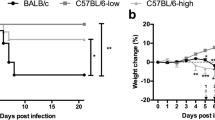Summary
We had previously showed that following intracerebral inoculation of newborn mice, the 910 N and M strains of bovine parainfluenza 3 virus induce a non-lethal hydrocephalus and a lethal diesease with marked thymic and splenic atrophy, respectively. Moreover, only the M virus was lethal for 2-week-old mice.
In the present study, we demonstrate that the M virus multiplies and spreads in the mouse brain invading the thalamus, hypothalamus and brain stem beyond the ependyma whereas the 910 N virus causes only slight ependymitis. This growth and spread of M virus was blocked by passive immunization 3 days after infection. Mouse embryo brain cell cultures were infected with M and 910 N viruses, about 50 per cent became antigenpositive for M whereas only a small proportion of cells were positive for the 910 N virus. However, the latter did produce higher yields of infectious virus than M.
Article PDF
Similar content being viewed by others
Avoid common mistakes on your manuscript.
References
Duffy, P. E., Wolf, A., Harter, D. H., Gamboa, E. T., Hsue, K. C.: Murine influenza virus encephalomyelitis II. Electron microscopic observations. J. Neuropath. Exp. Neurol.32, 72–91 (1973).
Kumanishi, T., Hirano, A.: An immunoperoxidase study on herpes simplex virus encephalitis. J. Neuropath. Exp. Neurol.37, 790–795 (1978).
Kumanishi, T., In, S.: SSPE: Immunohistochemical demonstration of measles virus antigen(s) in paraffin sections. Acta Neuropathol (Berl.)48, 161–163 (1979).
Margolis, G., Kilham, L., Baringer, J. R.: A new look at mumps encephalitis: Inclusion bodies and cytopathic effects. J. Neuropath. Exp. Neurol.33, 13–28 (1974).
Merz, D. C., Wolinsky, J. S.: biochemical features of mumps virus neuraminidases and their relationship with pathogenicity. Virology114, 218–227 (1981).
Merz, D. C., Wolinsky, J. S.: Conversion of nonfusing mumps virus infections to fusing infections by selective proteolysis of the HN glycoprotein. Virology131, 328–340 (1983).
Padgett, B. L., Rogers, C. M., Walker, D. L.: JC virus, a human polyomavirus associated with progressive multifocal leukoencephalopathy: Additional biological characteristics and antigen relationships. Infect. Immun.15, 656–662 (1977).
Shibuta, H., Adachi, A., Kanda, T., Matumoto, M.: Experimental parainfluenza-virus infection in mice: Fatal illness with atrophy of thymus and spleen in mice caused by a variant of parainfluenza 3 virus. Infect. Immun.35, 437–441 (1982).
Shibuta, H., Adachi, A., Kanda, T., Shimada, H.: Experimental parainfluenzavirus infection. I. Hydrocephalus of mice due to infection with parainfluenza virus type 1 and type 3. Microbiol. Immunol.22, 505–508 (1978).
Shibuta, H., Kanda, T., Adachi, A., Yogo, Y.: Characterization of bovine parainfluenza virus type 3. Microbiol. Immunol.23, 617–628 (1979).
Shibuta, H., Kanda, T., Hazama, A., Adachi, A., Matumoto, M.: Parainfluenza 3 virus: Plaque-type variants lacking neuraminidase activity. Infect. Immun.34, 262–267 (1981).
Shibuta, H., Nozawa, A., Shioda, T., Kanda, T.: Neuraminidase activity and syncytial formation in variants of parainfluenza 3 virus. Infect. Immun.41, 780–788 (1983).
Wolinsky, J. S., Baringer, J. R., Margolis, G., Kilham, L.: Ultrastructure of mumps virus replication in newborn hamster central nervous system. Lab. Invest.31, 403–412 (1974).
Wolinsky, J. S., Kelly, J. M., Baringer, J. R.: Ultrastructure of mumps virus replication in organotypic cultures of hamster choroid plexus. J. gen. Virol.30, 197–205 (1976).
Author information
Authors and Affiliations
Additional information
With 3 Figures
Rights and permissions
About this article
Cite this article
Shibuta, H., Kanda, T., Nozawa, A. et al. Experimental parainfluenza virus infection in mice: Growth and spread of a highly pathogenic variant of parainfluenza 3 virus in the mouse brain. Archives of Virology 83, 43–52 (1985). https://doi.org/10.1007/BF01310963
Received:
Accepted:
Issue Date:
DOI: https://doi.org/10.1007/BF01310963




